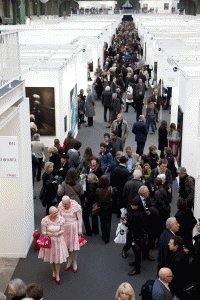« Editor's Picks
The End of the Art Fair Age?
By Raúl Martínez
Over the past few years critics have repeatedly addressed the hyperinflation of art fairs. The outburst of the financial crisis last autumn appeared to be an irrevocable signal, rushing many of them to proclaim the demise of this model. If you have attended The Armory Show, Art Basel, Frieze or the FIAC in 2009; you may start to suspect, however, that their prophecies were only a recurring conversation, because with attendance figures holding up, and lines at their doors defying economic logic, the claim that art fairs would die out seems unlikely. Whether they are the most appropriate model to show art is another question, which I will not address in this column.
Like most commercial enterprises, art fairs have certainly been hit by the current economic crisis. “Collectors are more choosy now. The days of the five-minute decisions are over,” admitted Christian Viveros-Fauné, Director of Volta art fair. But as reports demonstrate, sales are still happening when quality works are found at the right price. Similarly, dealers have also become more selective about the fairs they participate in, where booths can cost over $100,000. Fairs, which did not fulfill dealers’ expectations in the past, are therefore going to have a hard time attracting exhibitors. Some may need to reduce the price of booths, an unlikely alternative when sponsors are also cutting back, or take a “sabbatical,” like Barcelona’s emerging art fair SWAB, which announced it would be back after the crisis in 2010. Others are choosing to downsize and better edit the material displayed, as Artissima, ArcoMadrid and NextChicago have done recently. As Art Basel’s Co-Director Marc Spiegler said in a recent interview for Art in America, “It’s not the flea market model anymore, in which we just sold square meters and dealers brought whatever they could.” Viveros-Fauné agrees, “People are looking for content. Art fairs need to give primacy to the exhibition rather than follow the mall model.”
A recession does not, however, mean that the art fair model is near extinction. On the contrary, new art fairs continue to emerge, from JUSTMadrid to the highly publicized Art Abu Dhabi, and from Verge Miami to Pinta in London. Fairs play a crucial role in today’s global art market, and have become indispensable sales tools for galleries. As Katelijne de Backer, Director of the Armory Show, said, “Last year, at The Armory Show, we had over 56,000 visitors, including some 9,000 important collectors in our VIP program. How many galleries can claim that kind of traffic in a whole year?”
Another indicator, the number of art fairs scheduled for December in Miami, remains about the same as in 2008, since emerging galleries have immediately occupied the vacant slots in the Convention Center left by “deserters,” and new satellite fairs have replaced deceased ones. Galleries who did ten fairs in 2008 may do four fairs now, and those who used to do four fairs may do two. Yet as De Backer says, “I don’t think galleries can afford to lose access to the share of the international market art fairs provide.” “On the contrary, they are even more important in a contracted market,” adds Viveros Fauné, “Where else are galleries from Sao Paulo, Istanbul or Miami going to find buyers?”
Not unlike their historical precedents, the nineteenth century International Exhibition and the twentieth century World’s Fair, art fairs occupy a central position in today’s art world, allowing the public to discover the newest art production and trends. From the legendary Armory Show of 1913 to the recent art fairs in Dubai and Abu Dhabi, these shows have often been important as educational platforms, introducing contemporary art to the public even before museums were built. According to Paco Barragán, artistic director of Circa Puerto Rico and author of the The Art Fair Age, “over the past few years, art fairs have [actually] started to compete with biennials and museums as cultural destinations.”
As Andy Warhol stated in the 1970s, “New York restaurants do not sell their food, they sell their atmosphere.” Similarly, art fairs offer more than a menu of international art in a tight and crowded space. They are exciting platforms to see art and provide unparalleled networking opportunities. While the works displayed could easily be purchased at their respective galleries, or even bought online from JPEGS, many collectors seem to prefer buying at art fairs, which for some galleries represent up to 70% of sales. They offer art professionals and collectors the opportunity to meet periodically, exchange gossip, show off their latest acquisitions, or in rougher sociological terms, to see and be seen. And in our increasingly digital world, that human contact is becoming more and more valuable.
Raúl Martínez is an economist and writer based in New York



































